Antibacterial Effect and Mechanism of Chelerythrine on Xanthomonas oryzae pv. oryzae
Abstract
:1. Introduction
2. Materials and Methods
2.1. Bacterial Strains, Culture Conditions, and Chemical Agents
2.2. In Vitro Test for Antibacterial Activity of Chelerythrine Against Xoo
2.3. Effect of Chelerythrine on the Cell Structure of Xoo
Scanning Electron Microscopy (SEM)
2.4. Effect of Chelerythrine on Membrane Permeability of Xoo
2.5. Effect of Chelerythrine on the Pathogenicity of Xoo
2.5.1. Determination of Extracellular Polysaccharide (EPS) Production
2.5.2. Extracellular Cellulase Activity Assays
2.5.3. Effect of Chelerythrine on Biofilm Formation
2.6. Cell Mobility Test
2.7. Effect of Chelerythrine on Pyruvate Content of Xoo
2.8. Determination of ROS
2.9. TMT Quantitative Proteomic Sample Preparation
2.10. Protein Extraction, Quantification, Enzymolysis, and TMT Labeling
2.11. Instrumental Analysis
2.12. Data Analysis
2.13. Quantitative Real-Time PCR
2.14. Bioinformatics Analysis
2.15. Statistical Analysis
3. Results
3.1. In Vitro Test for Antibacterial Activity of Chelerythrine Against Xoo
3.2. Effect of Chelerythrine on the Cell Structure of Xoo
3.3. Effect of Chelerythrine on the Membrane Permeability of Xoo
3.4. Effect of Chelerythrine on Extracellular Cellulase of Xoo
3.5. Effect of Chelerythrine on the EPS Content of Xoo
3.6. Effect of Chelerythrine on Biofilm Formation of Xoo
3.7. Effect of Chelerythrine on Pyruvate Content of Xoo
3.8. Effect of Chelerythrine on Cell Mobility of Xoo
3.9. Effect of Chelerythrine on ROS of Xoo
3.10. Proteomic Analysis
3.10.1. Protein Identification and Quantification
3.10.2. GO Enrichment Analysis of DEPs
3.10.3. DEPs Involved in Cell Membrane and Cell Division
3.10.4. DEPs Involved in Oxidative Stress and DNA Repair
3.10.5. DEPs Involved in Chemotaxis and Bacterial Movement
3.10.6. DEPs in Nucleotide Synthesis
4. Discussion
4.1. Effects of Chelerythrine on Cell Division and Cell Membrane of Xoo
4.2. Effect of Chelerythrine on Oxidative Stress and DNA Repair of Xoo
4.3. Effect of Chelerythrine on the Pathogenicity of Xoo
4.4. Effect of Chelerythrine on Carbohydrate Metabolism of Xoo
4.5. Effect of Chelerythrine on the Nucleotide Metabolism of Xoo
4.6. Effect of Chelerythrine on the Energy Metabolism of Xoo
4.7. Effect of Chelerythrine on Biotin Synthesis of Xoo
4.8. Validation of TMT Proteomics Results by RT-PCR
5. Conclusions
Supplementary Materials
Author Contributions
Funding
Institutional Review Board Statement
Informed Consent Statement
Data Availability Statement
Acknowledgments
Conflicts of Interest
References
- Laborte, A.G.; Gutierrez, M.A.; Balanza, J.G.; Saito, K.; Zwart, S.J.; Boschetti, M.; Murty, M.V.R.; Vilano, L.; Aunario, J.K.; Reinke, R. RiceAtlas, a spatial database of global rice calendars and production. Sci. Data 2017, 4, 170074. [Google Scholar] [CrossRef] [PubMed]
- Khush, G.S. What it will take to feed 5.0 billion rice consumers in 2030. Plant Mol. Biol. 2005, 59, 1–6. [Google Scholar] [CrossRef] [PubMed]
- Dai, L.Y.; Liu, X.L.; Xiao, Y.H.; Wang, G.L. Recent advances in cloning and characterization of disease resistance genes in rice. J. Integr. Plant Biol. 2010, 49, 112–119. [Google Scholar] [CrossRef]
- Sukhwinder, S.; Sodhi, M.; Vikal, Y.; George, M.L.C.; Bala, G.S.; Mangat, G.S.; Garg, M.; Sidhu, J.S. DNA fingerprinting and virulence analysis of Xanthomonas oryzae pv. oryzae isolates from Punjab, northern India. Euphytica 2003, 130, 107–115. [Google Scholar] [CrossRef]
- Han, C.W.; Cheng, B.J.; Liang, G.R. Occurrence Characteristics and Integrated Prevention and Control Techniques of Bacterial Leaf Blight of Rice in Cold Regions. North. Rice 2008, 38, 125–126. [Google Scholar] [CrossRef]
- Mew, T.W.; Cruz, C.; Medalla, E.S. Changes in race frequency of Xanthomonas oryzae pv. oryzae in response to rice cultivars planted in the Philippines. Plant Dis. 1992, 76, 1029–1032. [Google Scholar] [CrossRef]
- Lee, S.W.; Choi, S.H.; Han, S.S.; Lee, D.G.; Lee, B.Y. Distribution of Xanthomonas oryzae pv. oryzae Strains Virulent to Xa21 in Korea. Phytopathology 1999, 89, 928–933. [Google Scholar] [CrossRef]
- Zhang, G.; Lu, F.; Huang, Z.G.; Chen, S.; Wang, X.K. Estimations of application dosage and greenhouse gas emission of chemical pesticides in staple crops in China. Ying Yong Sheng Tai Xue Bao 2016, 27, 2875–2883. [Google Scholar] [CrossRef]
- Łozowicka, B.; Hrynko, I.; Kaczyński, P.; Jankowska, M.; Rutkowska, E. Long-Term Investigation and Health Risk Assessment of Multi-class Fungicide Residues in Fruits. Pol. J. Environ. Stud. 2016, 25, 681–697. [Google Scholar] [CrossRef]
- Mongiano, G.; Zampieri, E.; Morcia, C.; Titone, P.; Volante, A.; Terzi, V.; Tamborini, L.; Vale, G.; Monaco, S. Application of plant-derived bioactive compounds as seed treatments to manage the rice pathogen Fusarium fujikuroi. Crop Prot. 2021, 148, 105739. [Google Scholar] [CrossRef]
- Chen, N.; Qi, Y.; Ma, X.; Xiao, X.; Liu, Q.; Xia, T.; Xiang, J.; Zeng, J.; Tang, J. Rediscovery of traditional plant medicine: An underestimated anticancer drug of chelerythrine. Front. Pharmacol. 2022, 13, 906301. [Google Scholar] [CrossRef] [PubMed]
- Danielewski, M.; Zielińska, S.; Matuszewska, A.; Słupski, W.; Włodarczyk, M.; Jęśkowiak, I.; Wiatrak, B.; Kowalski, K.; Jezierska-Domaradzka, A.; Ziółkowski, P.; et al. Sanguinarine-chelerythrine fraction of Coptis chinensis exerts anti-inflammatory activity in carrageenan paw oedema test in rats and reveals reduced gastrotoxicity. Oxidative Med. Cell. Longev. 2022, 2022, 1504929. [Google Scholar] [CrossRef]
- Qian, W.; Yang, M.; Li, X.; Sun, Z.; Wang, T. Anti-microbial and anti-biofilm activities of combined chelerythrine-sanguinarine and mode of action against Candida albicans and Cryptococcus neoformans in vitro. Colloids Surf. B Biointerfaces 2020, 191, 111003. [Google Scholar] [CrossRef]
- He, N.; Wang, P.; Wang, P.; Ma, C.; Kang, W. Antibacterial mechanism of chelerythrine isolated from root of Toddalia asiatica (Linn) Lam. BMC Complement. Altern. Med. 2018, 18, 261. [Google Scholar] [CrossRef]
- Duda-Madej, A.; Viscardi, S.; Szewczyk, W.; Topola, E. Natural Alkaloids in Cancer Therapy: Berberine, Sanguinarine and Chelerythrine against Colorectal and Gastric Cancer. Int. J. Mol. Sci. 2024, 25, 8375. [Google Scholar] [CrossRef]
- Wei, Q.H.; Cui, D.Z.; Liu, X.F.; Chai, Y.Y.; Zhao, N.; Wang, J.Y.; Zhao, M. In vitro antifungal activity and possible mechanisms of action of chelerythrine. Pestic. Biochem. Physiol. 2020, 164, 140–148. [Google Scholar] [CrossRef] [PubMed]
- Wianowska, D.G.; Cieniecka-Roslonkiewicz, S.; Typek, R.; Dawidowicz, A.L. Chemical composition and antifungal activity of Chelidonium majus extracts—Antagonistic action of chelerythrine and sanguinarine against Botrytis cinerea. Chem. Ecol. 2018, 34, 582–594. [Google Scholar] [CrossRef]
- Ulrichová, J.; Walterová, D.; Vavrečková, C.; Kamarád, V.; Šimánek, V. Cytotoxicity of benzo[c]phenanthridinium alkaloids in isolated rat hepatocytes. Phytother. Res. 2015, 10, 220–223. [Google Scholar] [CrossRef]
- Yamamoto, S.; Seta, K.; Morisco, C.; Vanter, S.F.; Sadoshima, J. Chelerythrine rapidly induces apoptosis through generation of reactive oxygen species in cardiac myocytes. J. Mol. Cell. Cardiol. 2001, 33, 1829–1848. [Google Scholar] [CrossRef]
- Lin, Y.L.; Zhang, Q.Z.; Xie, B.F.; Jiang, H.Y.; Shen, J.Z.; Tang, S.S.; Dai, C.S. Chelerythrine-induced apoptotic cell death in hepg2 cells involves the inhibition of akt pathway and the activation of oxidative stress and mitochondrial apoptotic pathway. Antioxidants 2022, 11, 1837. [Google Scholar] [CrossRef]
- Yang, T.F.; Xu, R.; Su, Q.; Wang, H.Y.; Liu, F.; Dai, B.L.; Wang, B.; Zhang, Y.M. Chelerythrine hydrochloride inhibits proliferation and induces mitochondrial apoptosis in cervical cancer cells via PI3K/BAD signaling pathway. Toxicol. Vitr. 2020, 68, 104965. [Google Scholar] [CrossRef] [PubMed]
- Wei, Q.H.; Cui, D.Z.; Zheng, B.J.; Zhao, M. In vitro antifungal activity of dihydrochelerythrine and proteomic analysis in Ustilaginoidea virens. Rice Sci. 2023, 30, 257–266. [Google Scholar] [CrossRef]
- Wei, Q.H.; Zhao, M.; Li, X.Y. Extraction of chelerythrine and its effects on pathogenic fungus spore germination. Pharmacogn. Mag. 2017, 13, 600–606. [Google Scholar] [CrossRef] [PubMed]
- Yang, P.; Li, F.J.; Huang, S.W.; Luo, M.; Lin, W.; Yuan, G.Q.; Li, Q.Q. Physiological and Transcriptional Response of Xanthomonas oryzae pv. oryzae to Berberine, an Emerging Chemical Control. Phytopathology 2020, 110, 1027–1038. [Google Scholar] [CrossRef]
- Kang, S.M.; Kong, F.H.; Shi, X.Y.; Han, H.J.; Li, M.H.; Guan, B.Y.; Yang, M.; Cao, X.Y.; Tao, D.B.; Zheng, Y.; et al. Antibacterial activity and mechanism of lactobionic acid against Pseudomonas fluorescens and Methicillin-resistant Staphylococcus aureus and its application on whole milk. Food Control 2020, 108, 106876. [Google Scholar] [CrossRef]
- Hwang, D.; Lim, Y.H. Resveratrol antibacterial activity against Escherichia coli is mediated by Z-ring formation inhibition via suppression of FtsZ expression. Sci. Rep. 2015, 5, 10029. [Google Scholar] [CrossRef] [PubMed]
- Haeusser, D.P.; Margolin, W. Splitsville: Structural and functional insights into the dynamic bacterial Z ring. Nat. Rev. Microbiol. 2016, 14, 305–319. [Google Scholar] [CrossRef]
- Ramirez-Diaz, D.A.; García-Soriano, D.A.; Raso, A.; Mücksch, J.; Feingold, M.; Rivas, G.; Schwille, P. Treadmilling analysis reveals new insights into dynamic FtsZ ring architecture. PLoS Biol. 2018, 16, e2004845. [Google Scholar] [CrossRef]
- Rai, D.; Singh, J.K.; Roy, N.; Panda, D. Curcumin inhibits FtsZ assembly: An attractive mechanism for its antibacterial activity. Biochem. J. 2008, 410, 147–155. [Google Scholar] [CrossRef]
- Niu, Z.D.; Lei, P.; Wang, Y.X.; Wang, J.X.; Yang, J.L.; Zhang, J.F. Small molecule LpxC inhibitors against gram-negative bacteria: Advances and future perspectives. Eur. J. Med. Chem. 2023, 253, 115326. [Google Scholar] [CrossRef]
- Gorzelak, P.; Klein, G.; Raina, S. Molecular Basis of Essentiality of Early Critical Steps in the Lipopolysaccharide Biogenesis in Escherichia coli K-12: Requirement of MsbA, Cardiolipin, LpxL, LpxM and GcvB. Int. J. Mol. Sci. 2021, 22, 5099. [Google Scholar] [CrossRef]
- Wei, J.R.; Richie, D.L.; Mostafavl, M.; Metzger, L.E., IV; Rath, C.M.; Sawyer, W.S.; Takeoka, K.T.; Dean, C.R. LpxK is essential for growth of Acinetobacter baumannii ATCC 19606:relationship to toxic accumulation of lipid Apathway intermediates. mSphere 2017, 2, e00199-17. [Google Scholar] [CrossRef]
- Zhou, P.; Hong, J.Y. Structure- and Ligand-Dynamics-Based Design of Novel Antibiotics Targeting Lipid A Enzymes LpxC and LpxH in Gram-Negative Bacteria. Acc. Chem. Res. 2021, 54, 1623–1634. [Google Scholar] [CrossRef] [PubMed]
- Hameed, P.S.; Manjrekar, P.; Chinnapattu, M.; Humnabadkar, V.; Shanbhag, G.; Kedari, C.; Mudugal, N.V.; Ambady, A.; de Jonge, B.L.M.; Sadler, C. Pyrazolopyrimidines Establish MurC as a Vulnerable Target in Pseudomonas aeruginosa and Escherichia coli. ACS Chem. Biol. 2014, 9, 2274–2282. [Google Scholar] [CrossRef]
- Schurig-Briccio, L.A.; Farías, R.N.; Rodríguez-Montelongo, L.; Rintoul, M.R.; Rapisarda, V.A. Protection against oxidative stress in Escherichia coli stationary phase by a phosphate concentration-dependent genes expression. Arch. Biochem. Biophys. 2009, 483, 106–110. [Google Scholar] [CrossRef] [PubMed]
- Liu, F.; Min, R.; Hong, J.; Cheng, G.Q.; Zhang, Y.Q.; Deng, Y.L. Quantitative proteomic analysis of ahpC/F and katE and katG knockout Escherichia coli—A useful model to study endogenous oxidative stress. Appl. Microbiol. Biotechnol. 2021, 105, 2399–2410. [Google Scholar] [CrossRef] [PubMed]
- Dip, P.V.; Kamariah, N.; Manimekalai, S.M.S.; Nartey, W.; Balakrishna, A.M.; Eisenhaber, F.; Eisenhaber, B.; Grüber, G. Structure, mechanism and ensemble formation of the alkylhydroperoxide reductase subunits AhpC and AhpF from Escherichia coli. Acta Crystallogr. Sect. D Biol. Crystallogr. 2014, 70, 2848–2862. [Google Scholar] [CrossRef] [PubMed]
- Neto, J.F.D.S.; Negretto, C.C.; Netto, L.E.S. Analysis of the Organic Hydroperoxide Response of Chromobacterium violaceum reveals that OhrR is a cys-based redox sensor regulated by thioredoxin. PLoS ONE 2012, 7, e47090. [Google Scholar] [CrossRef]
- Rhee, S.G.; Chae, H.Z.; Kim, K.K. Peroxiredoxins: A historical overview and speculative preview of novel mechanisms and emerging concepts in cell signaling. Free Radic. Biol. Med. 2005, 38, 1543–1552. [Google Scholar] [CrossRef]
- Kuper, J.; Kisker, C. Damage recognition in nucleotide excision DNA repair. Curr. Opin. Struct. Biol. 2012, 22, 88–93. [Google Scholar] [CrossRef]
- Modrich, P.; Lahue, R. Mismatch repair in replication fidelity, genetic recombination, and cancer biology. Annu. Rev. Biochem. 1996, 65, 101–133. [Google Scholar] [CrossRef]
- Azeroglu, B.; Mawer, J.S.P.; Cockram, C.A.; White, M.A.; Hasan, M.A.M.; Filatenkova, M.; Leach, D.R.F. RecG directs DNA synthesis during double-strand break repair. PLoS Genet. 2016, 12, e1005799. [Google Scholar] [CrossRef] [PubMed]
- Schormann, N.; Ricciardi, R.; Chattopadhyay, D. Uracil-DNA glycosylases-structural and functional perspectives on an essential family of DNA repair enzymes. Protein Sci. 2014, 23, 1667–1685. [Google Scholar] [CrossRef]
- Dharmapuri, S.; Sonti, R.V. A transposon insertion in the gumG homologue of Xanthomonas oryzae pv. oryzae causes loss of extracellular polysaccharide production and virulence. FEMS Microbiol. Lett. 1999, 179, 53–59. [Google Scholar] [CrossRef] [PubMed]
- Andersen, C. Channel-tunnels: Outer membrane components of type I secretion systems and multidrug efflux pumps of Gram-negative bacteria. Rev. Physiol. Biochem. Pharmacol. 2003, 147, 122–165. [Google Scholar] [CrossRef]
- Hou, B.; Meng, X.R.; Zhang, L.Y.; Tan, C.; Jin, H.; Zhou, R.; Gao, J.F.; Wu, B.; Li, Z.L.; Liu, M.; et al. TolC promotes ExPEC biofilm formation and curli production in response to medium osmolarity. J. Biomed. Biotechnol. 2014, 2014, 574274–574283. [Google Scholar] [CrossRef]
- Luo, H.Z.; Guan, Y.; Yang, R.; Qian, G.L.; Yang, X.H.; Wang, J.S.; Jia, A.Q. Growth inhibition and metabolomic analysis of Xanthomonas oryzae pv. oryzae treated with resveratrol. BMC Microbiol. 2020, 20, 117. [Google Scholar] [CrossRef]
- Deutscher, J.; Francke, C.; Postma, P.W. How phosphotransferase system-related protein phosphorylation regulates carbohydrate metabolism in bacteria. Microbiol. Mol. Biol. Rev. 2007, 70, 939–1031. [Google Scholar] [CrossRef] [PubMed]
- Erni, B. The bacterial phosphoenolpyruvate: Sugar phosphotransferase system (PTS): An interface between energy and signal transduction. J. Iran. Chem. Soc. 2012, 10, 593–630. [Google Scholar] [CrossRef]
- Wu, S.Q.; Xu, R.; Su, M.J.; Gao, C.; Liu, Y.; Chen, Y.J.; Luan, G.X.; Jia, X.; Wang, R. A pyrf-based efficient genetic manipulation platform in Acinetobacter baumannii to explore the vital DNA components of adaptive immunity for I-F CRISPR-Cas. Microbiol. Spectr. 2022, 10, e01957-22. [Google Scholar] [CrossRef]
- Alberti, M.; Sainas, S.; Ronchi, E.; Lolli, M.L.; Boschi, D.; Rizzi, M.; Ferraris, D.M.; Miggiano, R. Biochemical characterization of Mycobacterium tuberculosis dihydroorotate dehydrogenase and identification of a selective inhibitor. FEBS Lett. 2023, 597, 2119–2132. [Google Scholar] [CrossRef]
- Niazy, A.A.; Lambarte, R.N.A.; Alghamdi, H.S. De novo pyrimidine synthesis pathway inhibition reduces motility virulence of Pseudomonas aeruginosa despite complementation. J. King Saud Univ.-Sci. 2022, 34, 102040. [Google Scholar] [CrossRef]
- Tagawa, M.; Yamagata, H.; Udaka, S. Participation of purE gene in exoprotein accumulation by a protein-leaky mutant of Escherichia coli. Agric. Biol. Chem. 1980, 44, 877–882. [Google Scholar] [CrossRef]
- Chatterjee, S.; Sonti, R.V. Virulence deficiency caused by a transposon insertion in the purH gene of Xanthomonas oryzae pv. oryzae. Can. J. Microbiol. 2005, 51, 575–581. [Google Scholar] [CrossRef]
- Reed, L.J.; Hackert, M.L. Structure-function relationships in dihydrolipoamide acyltransferases. J. Biol. Chem. 1990, 265, 8971–8974. [Google Scholar] [CrossRef]
- Moxley, W.C.; Eiteman, M.A. Pyruvate production by Escherichia coli by use of pyruvate dehydrogenase variants. Appl. Environ. Microbiol. 2021, 87, e00487-21. [Google Scholar] [CrossRef]
- Koo, M.J.; Rooney, K.T.; Choi, M.E.; Ryter, S.T.; Choi, A.M.K.; Moon, J. Impaired oxidative phosphorylation regulates necroptosis in human lung epithelial cells. Biochem. Biophys. Res. Commun. 2015, 464, 875–880. [Google Scholar] [CrossRef] [PubMed]
- Huang, L.; Huang, L.X.; Zhao, L.M.; Qin, Y.X.; Su, Y.Q.; Yan, Q.P. The regulation of oxidative phosphorylation pathway on Vibrio alginolyticus adhesion under adversities. MicrobiologyOpen 2019, 8, e00805. [Google Scholar] [CrossRef]
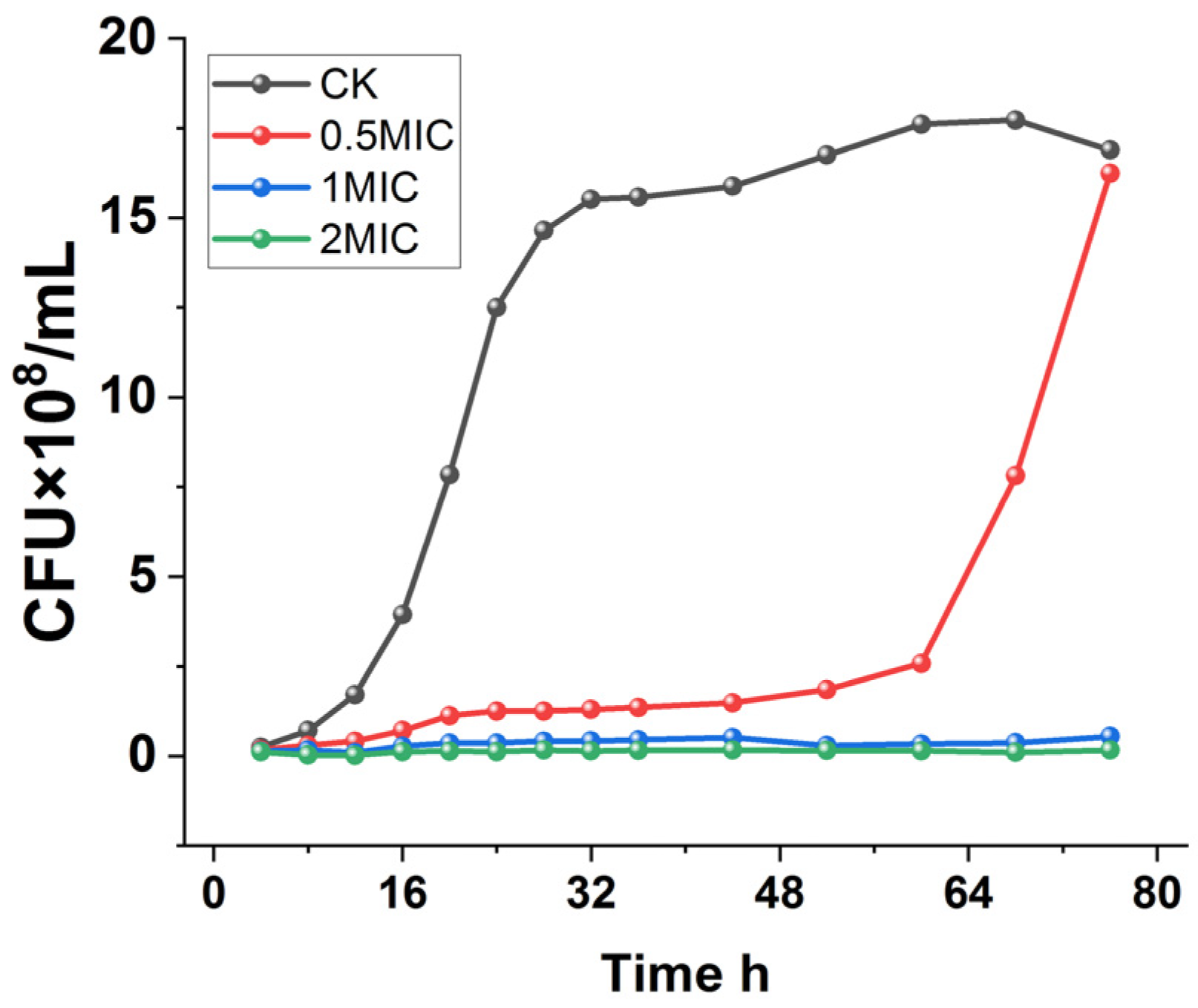

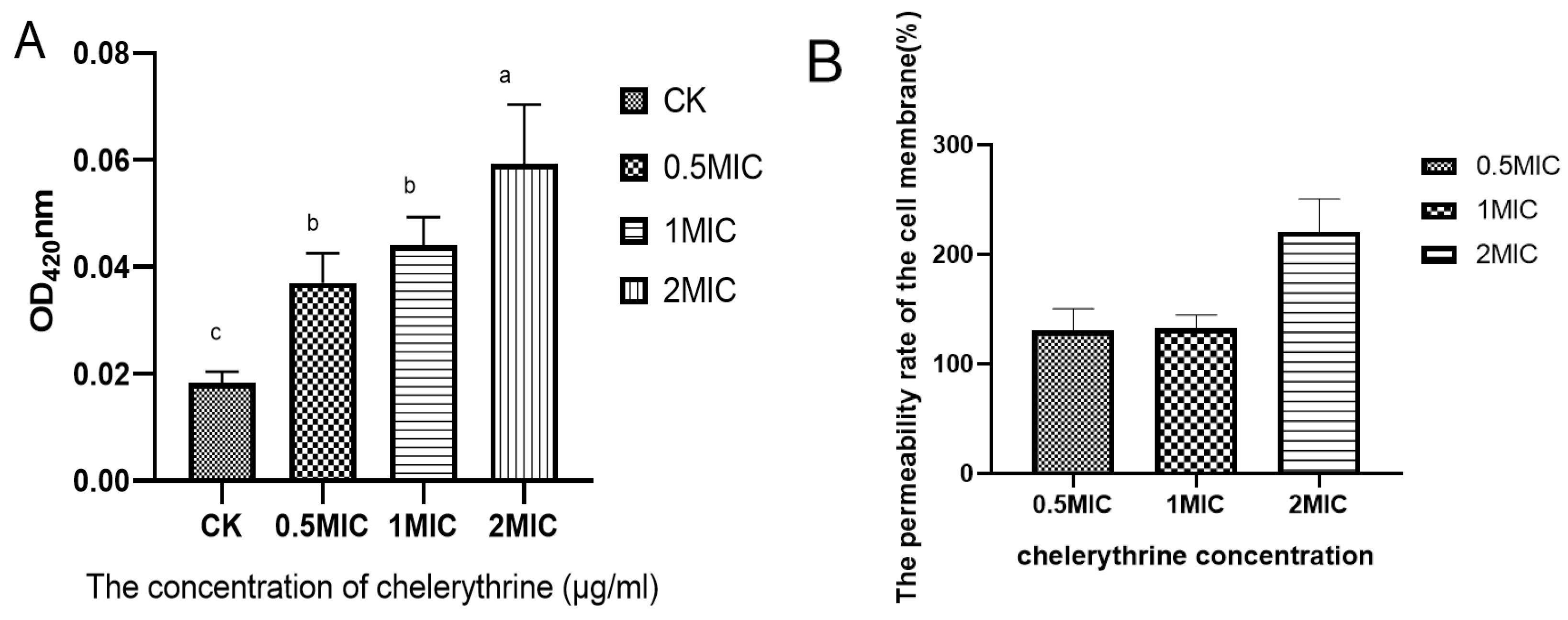

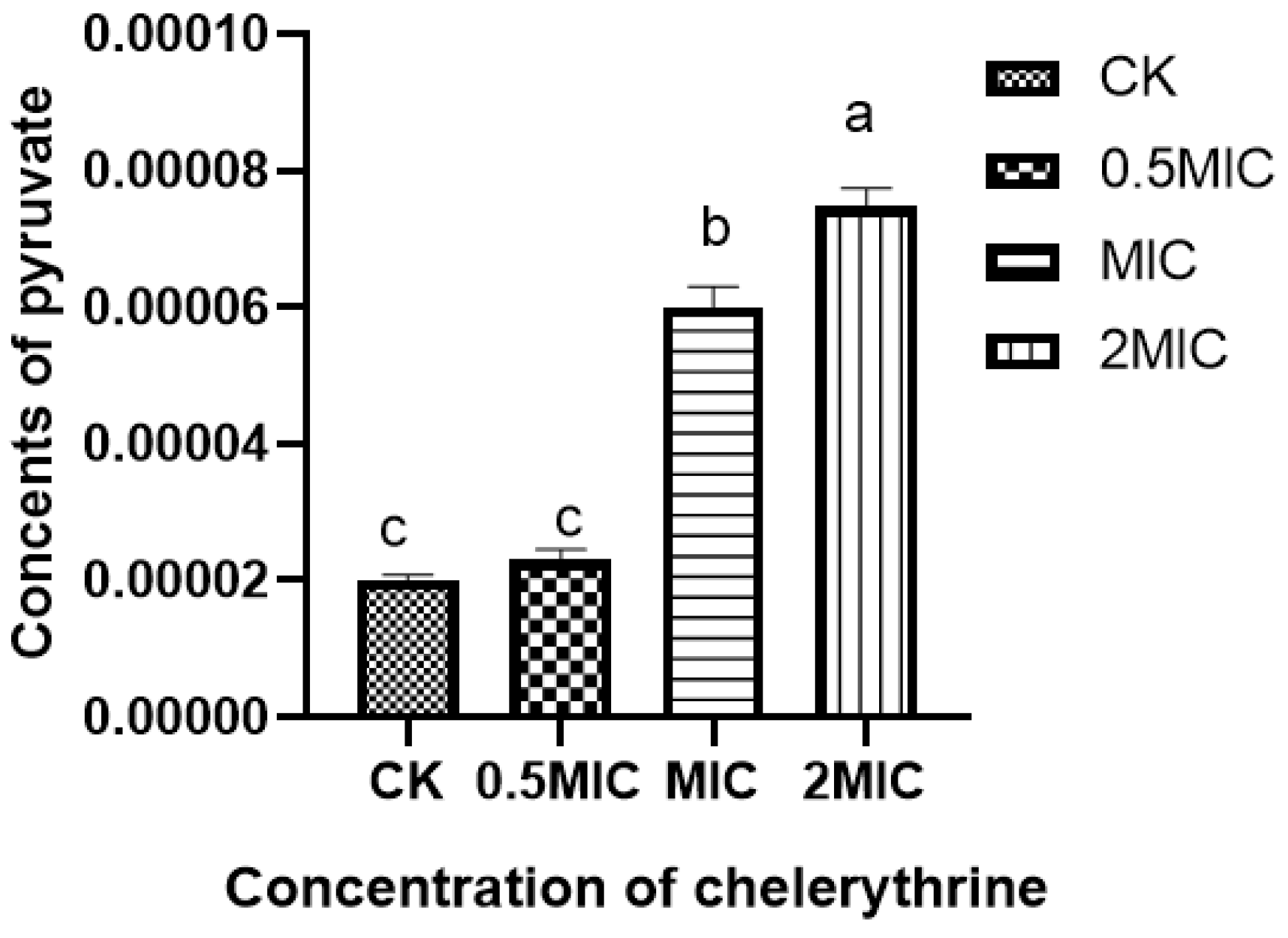
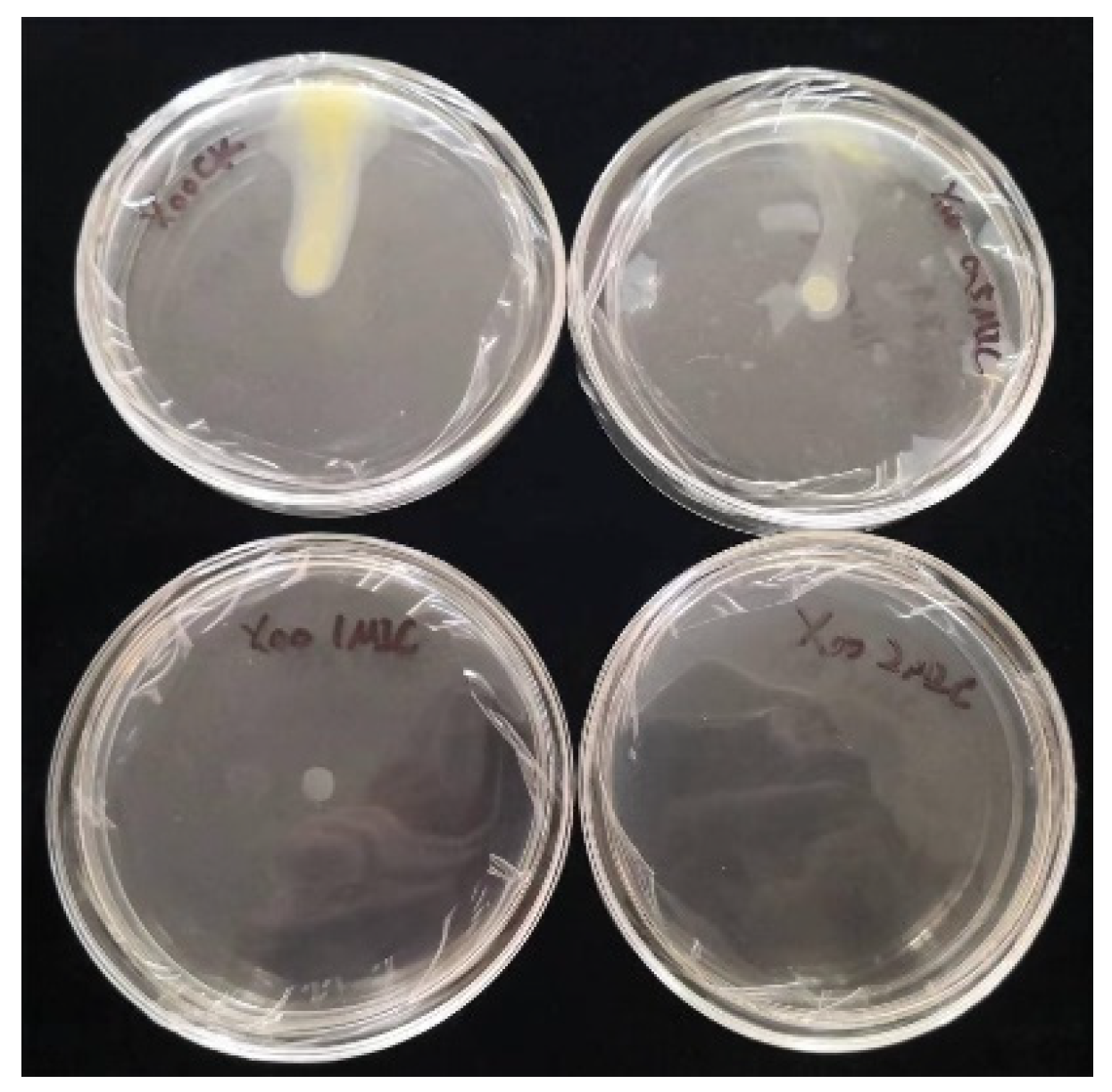
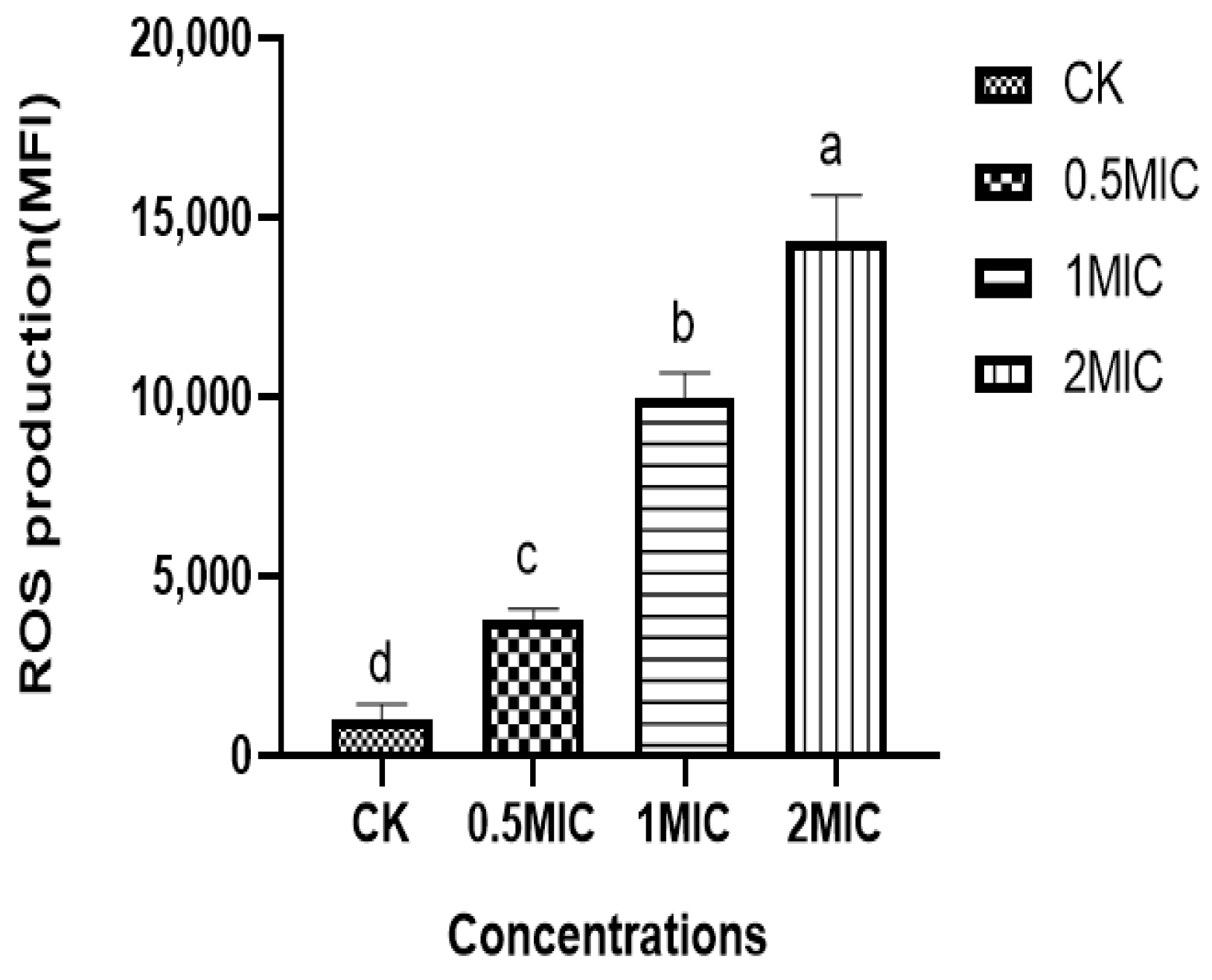
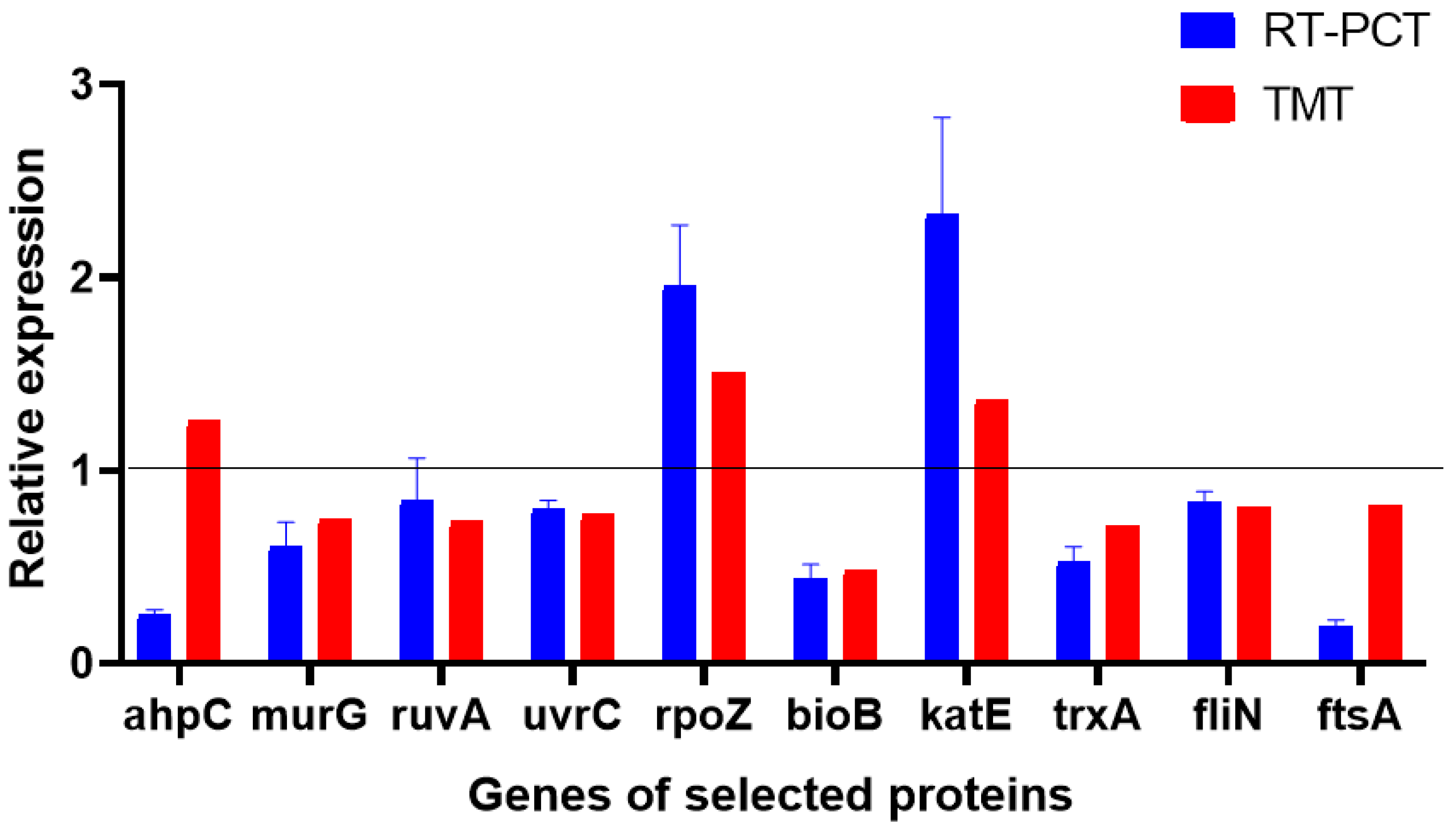
| Groups | CK | 0.5×MIC | 1×MIC | 2×MIC |
|---|---|---|---|---|
| D/d | 1.879 ± 0.030 a | 1.667 ± 0.031 b | 1.531 ± 0.008 c | 1.446 ± 0.009 d |
| NameTreatments | CK | 0.5×MIC | 1×MIC | 2×MIC |
|---|---|---|---|---|
| Extracellular polysaccharide production (µg/mL) | 14.122 ± 0.046 a | 12.942 ± 0.241 b | 12.410 ± 0.160 b | 10.905 ± 0.284 c |
| Groups | CK | 0.5×MIC | 1×MIC | 2×MIC |
|---|---|---|---|---|
| Diameter of motility (mm) | 44.5 ± 0.404 a | 44.3 ± 0.448 a | 4.63 ± 0.067 b | 4.57 ± 0.167 b |
Disclaimer/Publisher’s Note: The statements, opinions and data contained in all publications are solely those of the individual author(s) and contributor(s) and not of MDPI and/or the editor(s). MDPI and/or the editor(s) disclaim responsibility for any injury to people or property resulting from any ideas, methods, instructions or products referred to in the content. |
© 2025 by the authors. Licensee MDPI, Basel, Switzerland. This article is an open access article distributed under the terms and conditions of the Creative Commons Attribution (CC BY) license (https://creativecommons.org/licenses/by/4.0/).
Share and Cite
Yan, Y.; Wang, J.; Zhao, N.; Cui, D.; Zhao, M. Antibacterial Effect and Mechanism of Chelerythrine on Xanthomonas oryzae pv. oryzae. Microorganisms 2025, 13, 953. https://doi.org/10.3390/microorganisms13040953
Yan Y, Wang J, Zhao N, Cui D, Zhao M. Antibacterial Effect and Mechanism of Chelerythrine on Xanthomonas oryzae pv. oryzae. Microorganisms. 2025; 13(4):953. https://doi.org/10.3390/microorganisms13040953
Chicago/Turabian StyleYan, Yi, Jueyu Wang, Na Zhao, Daizong Cui, and Min Zhao. 2025. "Antibacterial Effect and Mechanism of Chelerythrine on Xanthomonas oryzae pv. oryzae" Microorganisms 13, no. 4: 953. https://doi.org/10.3390/microorganisms13040953
APA StyleYan, Y., Wang, J., Zhao, N., Cui, D., & Zhao, M. (2025). Antibacterial Effect and Mechanism of Chelerythrine on Xanthomonas oryzae pv. oryzae. Microorganisms, 13(4), 953. https://doi.org/10.3390/microorganisms13040953




